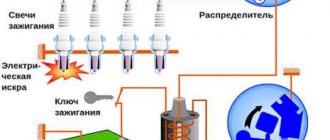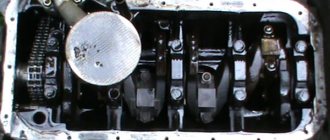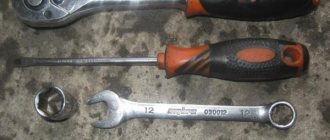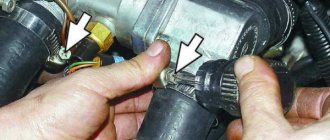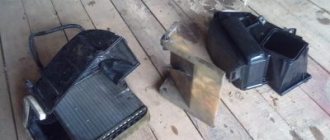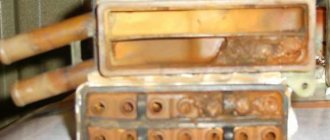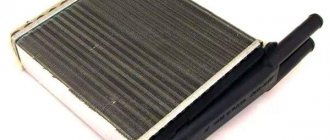VAZ 2107 signs of engine overheating
Modern car engines are able to automatically maintain temperature. But sometimes the instrument needle confidently climbs into the red zone and the engine “boils”, that is, it overheats. Why is this happening?
VAZ-2107 engine is overheated
The first reason, no matter how trivial, is the usual lack of coolant, which gradually evaporates. The problem can be solved simply, you need to refuel the cooling system. A lack of coolant can also occur due to its leakage in the connections or due to cracking of the hoses. As a rule, leaks can be detected by visually inspecting the engine. Broken hoses must be replaced, and loose connections must be tightened. In classic VAZ models, for example VAZ-2107, the radiator is connected to the expansion tank via a flexible tube. There have been cases when this tube gets clogged, as a result there is liquid in the tank, but not enough in the radiator. Therefore, do not be lazy to open the radiator cap once again and check for the presence of coolant.
The second reason for engine overheating may be a malfunctioning thermostat. If the thermostat breaks down, antifreeze does not enter the radiator, which causes overheating. The malfunction is easily determined. If the thermometer shows a coolant temperature of 90 degrees or higher, but the radiator remains cold, it means that the thermostat is faulty. The problem is resolved by replacing it. More details about the thermostat can be found here.
A third reason for overheating may be stagnation of fluid in the cooling system. This could be a faulty pump or a clogged system. A faulty pump should be replaced, and blockages should be removed by flushing the system with a special flushing fluid.
Another reason may be contamination of the radiator. Along with the incoming air flow, many foreign objects enter its cells: dust, insects, grass. This leads to the “greenhouse effect”. A layer of dirt covering the radiator disrupts the heat transfer process. Clean it periodically with a stiff brush and blow with compressed air.
The radiator is clogged with dirt
It is also worth paying attention to the temperature sensor. The signal from it goes to the car’s on-board computer or directly to the indicator. If the sensor is faulty, an incorrect signal from it can seriously interfere with the normal operation of the cooling system.
Source
Bleeding the system
Radiator for the cooling system of a carburetor engine VAZ 2108, 2109, 21099
On VAZ 2107 cars and its analogues (models 2101-2106), you can remove the traffic jam very simply. It is enough to remove the pipe that goes to the carburetor to heat the damper. If an injector is installed, then remove the pipe going to the throttle assembly.
Then fill the radiator with antifreeze. And do not forget that the stove tap must be opened. When it is full, you need to squeeze all the pipes with your hands (or rather, the top and bottom). The antifreeze should go away.
Add the missing amount and start the engine. Warm it up and carefully monitor the level, sometimes add antifreeze. You will have to add about three liters. And watch when fluid comes out of the tube connected to the carburetor.
When this happens, you need to put it in place and tighten the clamp. Of course, if you stop there, you won’t be able to get rid of the breakdown. The antifreeze still boils, the temperature rises. And why does this happen? Do a few more procedures and everything will return to normal.
Put on a glove and continue to slowly crimp the pipes. In this case, you need to install a plug on the radiator, and there should be antifreeze in the expansion tank between the two marks. That's all, there is no air, circulation occurs normally.
One small piece of advice: when refueling the system, it is advisable to position the car so that its front is higher than its rear. This will ensure that the system is completely filled. As a result, the antifreeze does not bubble or boil, the car runs like a watch.
texako › Blog › Engine overheating. Causes and consequences of overheating.
Engine overheating is a very deep topic and perhaps the most common cause of engine failure, which can lead to much more serious consequences. The causes and consequences of overheating will be described below. There are a great many possible causes of overheating and their number is limited only by a person’s fantasy and imagination.
Well, first, let's look at the most common causes of overheating:
✔ Clogged radiator ✔ Faulty thermostat ✔ Faulty coolant temperature sensor ✔ Fan malfunction, be it an electric fan or a fluid-coupled fan ✔ The water pump drive belt breaks or the pump itself fails ✔ Low coolant level, this can happen if you do not monitor the car or the coolant is leaking a little somewhere. ✔ Overheating occurs much less often in the complete absence of coolant ✔ If the engine starts to run wild, then overheating cannot be avoided either
Slight engine overheating - the engine ran for 5-10 minutes at elevated temperatures. This happens when a fan or thermostat fails, but the driver notices overheating in time and turns off the engine. In this case, the consequences are minimal - the pistons may melt a little, most modern engines may not feel short-term overheating. If the overheating was good, then it will make itself felt with black smoke and the feeling that the engine is constantly running under load, and the engine will also heat up due to the increased friction resistance of the melted pistons and aluminum remaining on the cylinder walls.
Noticeable overheating of the engine - the engine operated at an elevated temperature for more than 20 minutes. The reason could be one of the above or any other. The consequences are the same as with mild overheating, but to a greater extent, plus they may be added to the distortion of the plane of the cylinder head or the formation of a crack in the cylinder head, which can lead to the valve seat flying out. The cylinder head gasket may burn out. The inter-ring partitions on the pistons may be destroyed. On aluminum blocks, the plane on which the cylinder head is installed may be bent. All kinds of oil seals will begin to leak oil.
Severe overheating causes more serious consequences - the engine may knock or seize, much worse if the engine shows a fist of friendship. With severe overheating, the consequences are usually more than serious - almost none of the main working parts of the engine can survive.
It all starts in the combustion chambers of the engine: in the absence of cooling, the pistons begin to melt and burn into the flesh until holes form in them and until they are completely destroyed, molten aluminum sticks to the walls of the cylinders, which makes the piston stroke even more difficult - the engine may stall, or maybe not. At the same time, the engine oil heats up to temperatures at which it loses its properties and becomes like water, lubrication of the rubbing parts stops, the main and connecting rod bearings begin to melt and stick to the crankshaft, after which some of them can turn both on the connecting rods and and in the block - the engine may stall, or maybe not. Under the influence of high temperatures without cooling, the cylinder head begins to deform, valves burn out, one or more valve seats fly out, a sharp loud knock appears in the upper part of the engine - the engine may stall, or maybe not.
Then the finale: the piston turns out to be a tough nut to crack and is the first to fail to withstand the crankshaft - on one of the journals, where the liner was rotated, a crack had formed in advance, just at the point where the crack formed, the crankshaft breaks in half - the engine may stall, or maybe not.
Why does the engine get hot?
A single case of engine overheating will have minor consequences, but if it happens constantly, prepare for unpleasant consequences. Rubber products lose their elasticity, rings become stuck, scuffs appear on the cylinders and pistons, etc. Why the engine overheats, the reasons and how to fix the problem in this article.
What is engine overheating
The operating temperature of the engine is 80 - 95°C, that is, the entire green zone. The thermostat operates in other ranges, turning the fan on and off. But even working airflow does not guarantee against overheating. For the VAZ 2107, the thermostat begins to open at 82°C. The thermostat of the VAZ 21126 Priora engine begins to open at a temperature of 85 + 2°C, and opens completely at 102°C; for a gazelle with a 405 engine it is 92-102°C.
Overheating can be considered the operation of the motor at a temperature of 105 - 120 ° C for some time. To warn against this, in the car, in addition to the temperature sensor, there are also alarms. Well, if they didn’t work, then a direct indication is when the antifreeze knocks out of the expansion tank. It can be divided into short-term, medium and high heat.
Short-term overheating within a few minutes may go unnoticed by the engine or may manifest itself as a slight increase in oil consumption.
With an average time of more than 20 minutes, oil leaks and increased fuel consumption may occur. There may be a burnout of the cylinder head gasket or a coolant leak through a crack in the head. The pistons melt and the rings get stuck in them.
Blown cylinder head gasket
Strong heating can result in all of the above with loud knocking noises. The motor jams or even collapses (the engine shows the fist of friendship).
Why does the engine get hot?
Preconditions that cause overheating can be:
- cooling system malfunction;
- engine malfunction;
- malfunction of the running and braking system.
Reasons that can cause overheating
Cooling system
- Low coolant level. The cooling system is not 100% sealed. This can be seen in the expansion tank. When the engine is cold there is less coolant in the tank, after warming up there is more. The liquid evaporates and its level must be checked periodically. Antifreeze and antifreeze have greater fluidity than water. Make sure there is no fluid leakage.
The radiator cap must be in good condition and withstand the pressure in the system, this is also important.
The radiator cap must be in good condition
- Dirty radiator. The external honeycombs of the radiator are small and over time become clogged with insect remains, debris, dust and sand. Getting oil on it makes the situation even worse. And in hot weather when driving slowly, you are guaranteed to overheat the engine.
- Internal contamination of the radiator and engine. Malfunction is less common, but it does happen. The use of high-quality coolant guarantees the cleanliness of the system. However, buying a counterfeit product, as well as adding water if urgently necessary, or simply driving on water, leads to deposits on the walls of the engine and radiator.
If you already have to ride on water, then try not to delay it and quickly switch to antifreeze.
- Fan switch sensor and relay. Older, carburetor models originally had a fan driven by a belt and did not have such problems. In modern cars, the fan is rotated by an electric motor, which consequently complicates the design and leads to breakdowns. When driving fast, this may not appear, but driving around the city in the heat, and even if there are traffic jams, will be simply impossible.
Radiator switch on VAZ 2107
On the VAZ 2107, the most common malfunction is a breakdown of the fan relay. Of course, both the electric motor and the sensor itself can break down. Checking the serviceability of the electric motor is quite simple. It is enough to remove the connector from the sensor and if it is working properly, it will begin to rotate. There was an article about these faults and their diagnosis.
- Airlock. If you notice that the engine is heating up after replacing the antifreeze, the reason will be that the system is not completely filled with liquid. The air remaining in the system will interfere with the circulation of the fluid and, as a result, the engine will quickly heat up.
Each car has its own sore spots, for the seven it’s the stove. For more details, see the article on how to fill antifreeze.
- Thermostat. A frequent failure of a part is jamming in a position that prevents the full circulation of coolant in a large circle. In summer, this leads to the engine heating up in a traffic jam, and in winter, the interior is poorly heated.
You can independently determine this malfunction by feeling the lower radiator hose. If the engine is warm or even cold when the engine is hot, this is a direct indication of a faulty thermostat.
- Water pump. Otherwise, the water pump forces coolant through the system. The main failure is wear of the impeller. In carburetor VAZ models, it was possible to see the circulation of fluid by removing the radiator cap on a warm engine. Injection models have a lid on one side, and the upper pipe on the other, and the circulation in the radiator hole is invisible.
Engine overheating: symptoms and causes
As is known, violation of the temperature regime during operation of an internal combustion engine can lead to serious consequences. In summer, one of the most pressing problems is effective engine cooling. In other words, it is important to prevent the car engine from overheating.
It is quite obvious that the driver must independently monitor the condition and temperature of the engine. In this article, we intend to talk about what symptoms and signs indicate an overheated engine, what you should pay attention to when driving, and how to prevent engine overheating.
The engine is overheating: signs of a malfunction
So, if overheating occurs, thick white steam should not always come out from under the hood. The main cause for concern is the reading of the coolant temperature arrow on the dashboard.
Most cars use exactly this type of internal combustion engine temperature control scheme. An indicator light can also be installed, and an increase in temperature above the specified limits will be accompanied by a characteristic sound signal.
If the engine overheats while driving, then the main symptom is a sharply rising coolant temperature; the temperature gauge arrow on the panel tends to the red zone. In parallel with this, there is a significant drop in power; the power unit simply does not pull.
The engine itself begins to work more “hard” and noisier. Loud metallic knocks can be clearly heard, and fingers begin to “ring.” Such changes occur as a result of engine detonation, when fuel combustion in the cylinders becomes explosive.
You can also determine overheating by looking at the spark plugs. As a rule, a significant increase in temperature in the combustion chamber is indicated by a white coating on the electrodes, as well as the general condition of the spark plug (cracking of the insulator, etc.).
You can also open the cap of the expansion tank of the cooling system (only after the engine has cooled down). Signs of engine overheating, which can be determined upon inspection, are darkening on the walls of the tank (gray-black spots). Additionally, you should look at the antifreeze itself. If dark-colored flakes are visible in the coolant, then this is oil that has entered the cooling system as a result of overheating.
Typically, oil ingress occurs after damage (burnout) of the cylinder head gasket. At the same time, it is necessary to remove the oil dipstick and unscrew the oil filler cap. If foam is visible in the oil and an emulsion is observed under the cap, then antifreeze has entered the lubrication system.
Engine overheating: causes
Let's start with the fact that there are many reasons for engine overheating. Some, let’s say, lie on the surface, while others may be hidden and have no obvious signs.
The lubricant loses its properties, and the main and connecting rod bearings quickly fail. If the engine emits white smoke, this may be a clear sign of coolant in the cylinders.
This leads to the temperature of the exhaust gases rapidly rising, the cylinder head overheating, and the antifreeze in the channels also gets very hot and boils. Let us add that burnout of the exhaust valve also leads to similar consequences.
Local engine overheating
It should also be remembered that so-called local overheating may occur inside the engine. The difficulty is that it is not always possible to notice such a problem in a timely manner.
The air in the cabin does not heat up for a long time - what is the reason?
Another big problem with warming up a car for a long time in winter is that it takes too long for the air in the cabin to warm up.
You have to drive with terribly cold air from the air deflectors, scrape ice off the glass in the cabin and encounter various other troubles. Therefore, solving this problem is often a priority. It is worth paying attention to several possible reasons for this unpleasant effect:
- general problems with warming up the engine, which we discussed above, because if the fluid is not warmed up, then cold air will enter the cabin, this is an inevitable consequence;
- blockage in the cooling system - there may be air pockets in the stove itself, which do not in any way affect the quality of operation of the rest of the system; they can be eliminated at service stations;
- problems in the heater radiator - often the radiator itself is the cause of problems, it can be clogged, dirty inside or outside, which causes the effect of cold air in the cabin;
- clogged air ducts - often the problem of foggy glass and cold in the cabin is connected, it is worth cleaning the air ducts and inspecting them by removing the front panel and other parts in the cabin;
- broken switches and regulators - often car owners come to service stations who do not suspect that the temperature in the cabin is cold due to a non-functioning temperature control knob.
These are the unusual reasons that can occur when the interior is poorly heated. As a rule, such problems also include fogging and icing of the windows in the cabin, terrible stale air during a long trip, unpleasant odors, high humidity and even dampness. Such effects will clearly not benefit your car, nor will they provide a pleasant experience when using the vehicle. So you should get rid of them as soon as possible.
Watch a video on how to check the thermostat's operation:
Tips and tricks
In practice, most drivers, noticing an increase in temperature, strive to turn off the engine as quickly as possible. Please note that if the arrow is in the red zone, then this decision can be considered the only correct one.
However, if there is overheating, but the temperature has not reached a critical level, then it is better not to turn off the engine immediately. It is optimal to immediately reduce the speed, then stop the car and let the unit run for a couple of minutes.
The fact is that this method helps to avoid deformation and cracking of highly heated parts after they have cooled. It is also forbidden to open the expansion tank cap on a hot engine, as this may cause burns. It is also forbidden to add coolant to the tank until the engine has cooled down. The difference in temperature between heated engine parts and the liquid being poured can also cause deformation.
At the same time, it is necessary to check the functionality of the pump at each service, as well as the condition of the drive belt. In some cases, attention should be paid to the temperature sensor, which is responsible for triggering the cooling fan.
An additional recommendation is to wash the radiator and engine compartment. In this case, it is necessary to carry out all work correctly so as not to flood the electrical equipment, damage the radiator, cooling fan, etc. For older cars, it is also advisable to carry out internal cleaning of the cooling system and rinse the radiator from scale and rust.
Let us also add that if in winter the engine and engine compartment were insulated using various insulation materials, then all of these elements must be removed in order to improve cooling and reduce the load on the system.
Radiator fan
As you understand, the engine operates in a variety of modes. Sometimes he pulls the car along the highway at high speed, and sometimes through a traffic jam. And in the latter case, the speed is lower than that of pedestrians.
What's the difference? And the fact is that the radiator on a VAZ 2107 car is blown in these two modes with different amounts of air. In the first case, the flow is enough to maintain the temperature balance, but in the second it is not enough
And it doesn’t matter whether it’s an injector or a carburetor, the radiator must be blown normally
You have to create an artificial flow using an electric fan. In earlier VAZ 2107 cars (and indeed in the “classic” series) impellers were used that were mounted on the axis of the liquid pump. With the help of these mechanisms, the radiator is subjected to airflow. An electric fan may not perform its functions for the following reasons:
- The impeller has been destroyed.
- The sensor responsible for turning on the fan has failed.
- The motor winding burned out.
- Destruction of electrical wiring (breakage, contact failure, oxidation).
- Failure of a relay, fuse, button (if these elements are present in the design).
The last point applies mostly to VAZ 2107 cars, in which the fan switching circuit has been modified by installing a button in the passenger compartment. With its help, the driver can forcefully start the fan.
If it doesn’t start even from the button, you need to find out the reasons. To do this, connect the wires from the fan to the battery terminals. If it doesn’t work, the motor winding is damaged.
Please note: for better airflow, use a diffuser! This is a small plastic element that will force more air to flow to the radiator. And if there are no breakdowns in the fan, then be sure to install a diffuser, the radiator will thank you
What's the result?
Taking into account the above, it becomes clear that the engine structurally has many parts and assemblies that are very sensitive to changes in temperature conditions. If we talk about even minor overheating, the valve seals are the first to fail, then the piston rings.
However, when overheating is more serious, then there is a high probability of burnout of valves, cylinder head gaskets, deformation of the mating planes of the cylinder head and head, etc. As for serious problems, it should be remembered that heating inevitably leads to the expansion of parts, as a result of which cracks in the block and head appear, elements are deformed and melted. In the worst case scenario, an overheated engine seizes.
Finally, I would like to add that all diagnostic and preventive procedures must be performed correctly, since the cooling system consists of a large number of rather fragile parts. For example, even careless external pressure washing of a radiator can damage its fins.
Signs, causes and consequences of car engine overheating
One of the most dangerous and common problems that entails serious consequences in the form of a major overhaul of the internal combustion engine or its replacement is engine overheating. This problem mainly occurs in the summer, but some faults can cause this problem in cooler periods. It is easier to avoid overheating of the car's heart than to later eliminate the serious consequences of even a single excess of operating temperature. To do this, you need to know the symptoms and ways to quickly eliminate such a problem.
Reasons why the engine may overheat
The cooling system, which can be filled with antifreeze, antifreeze or plain water, protects the internal combustion engine from overheating.
The main devices that monitor operating temperature and reduce it are:
A malfunction in any of the above components can lead to overheating. In addition to malfunctions of the above devices, overheating can be caused by both external factors and other internal faults.
External overheating
If symptoms of overheating appear, it is necessary to carry out an external inspection of the radiator, motor and cooling system.
The main causes of external overheating:
Internal overheating
There are many reasons for internal overheating, and not all of them can be detected visually, and some will have to be looked for by a qualified car mechanic.
Causes of internal combustion engine overheating:
Consequences of mild, moderate and severe overheating
The consequences and cost of repairs depend on the degree of overheating of the internal combustion engine. Timely maintenance of the car, monitoring the coolant level and temperature conditions when driving reduces the occurrence of overheating significantly.
Slight overheating of the internal combustion engine occurs when the engine operates at a temperature exceeding the temperature for 4-12 minutes. This mainly occurs when the thermostat or fan malfunctions, and the driver detects this in a timely manner and takes action.
In many cases, such a situation, if it occurs once, does not affect the condition of the engine, especially if it has a short mileage. The pistons often melt slightly; when the temperature rises significantly, even for a short time, dark-colored smoke appears from the muffler, and there is a feeling that the engine is constantly running under load.
Even after a single short-term overheating of the engine, it will subsequently begin to heat up more often due to changes in the pistons and the remaining melted metal in the cylinders.
The average degree of overheating of the internal combustion engine appears when the engine is running at extreme temperatures for at least 20 minutes. There are many reasons for this situation and they have all been described earlier.
The consequences of such overheating are already more tragic. In addition to the consequences characteristic of mild overheating, which manifest themselves to a greater extent, there are added skew of the cylinder head or the appearance of cracks in it, burnout of cylinder head gaskets, ejection of the valve seat, severe deformation of the pistons, destruction of the inter-ring partitions of the pistons, oil leakage from under all kinds of gaskets and seals .
Severe overheating of the internal combustion engine causes all sorts of very serious consequences. In this case, individual working units may survive or the engine can be thrown out.
The main consequences of excessive engine overheating:
What are the consequences of poor engine warm-up before driving?
Many will say, so what if the engine doesn’t heat up to the required temperatures? After all, the car drives, and sometimes not worse than at operating temperatures. The issue of warming up is incredibly important for the normal operation of the car, and there are many explanations for this. It is not for nothing that the manufacturer sets the operating temperature range of the unit with an accuracy of a degree; this is an important indicator for the long service life of the motor and the preservation of its characteristics. These are the problems you can get with incomplete warming up:
- Failure of the cooling system. Sensors, thermostat and other parts are designed to operate normally at certain temperatures. Deviations can be caused by various phenomena.
- Wear of engine parts. You'll feel it when it's time to do major renovations. And this time will come quickly enough if the engine operates at low temperatures.
- Increased fuel consumption. On domestic engines, when operating at low temperatures, consumption can increase to obscene figures, and this greatly impacts the owner’s pocket.
- Reduced engine power. Along with the increase in consumption, there is the problem of a significant increase in the load on the parts, and therefore the efficiency of the engine decreases.
- Risk of expensive breakdowns. In addition to simple wear and tear, you also run the significant risk of a seized motor or other unpleasant consequences, which are very real and happen every day in Russia.
Special climatic conditions in the Russian Federation force us to pay special attention to the operation of the car. Otherwise, within a few years after purchasing a new car, you will have a pile of scrap metal, destroyed by domestic climatic conditions. And the issue of warming up the power plant is one of the most serious in terms of the duration and quality of operation of one of the most expensive components in a car.
What to do if the engine has already started to overheat
If overheating has begun or is suspected, it is necessary to take immediate action to avoid serious problems with the engine in the future.
If the needle has just entered the red zone (overheating zone), then you can turn off the engine, but it is advisable to cool it a little by turning it on to the maximum temperature and blowing on the stove.
In any case, it is necessary to inspect the radiator and engine compartment. If there is liquid in the expansion tank, then you can cool the engine a little by turning on the heater fan to the maximum temperature and blowing mode.
If there is a complete absence of coolant in the tank, turning on the heater at maximum mode will not help cool the internal combustion engine, and may worsen the situation. In this case, it is necessary to turn off the engine and transport the car to the repair site using a tow truck.
If minor leaks are detected in the cooling system after the engine has cooled, it is possible to add water or coolants. Under no circumstances should you add any liquid to the expansion tank of a hot engine, since the difference in temperatures can lead to cracks in different components of the internal combustion engine or other consequences.
It is strictly forbidden to water the engine, since in this case its repair is inevitable due to the appearance of cracks in the cylinder block body.
An overheated engine is turned off only in certain cases: when steam appears from under the hood, indicating a significant leak in the cooling system, or a complete absence of coolant in the tank.
Even a slight overheating of the motor, at best, will lead to unpleasant consequences in the future, and significant overheating can almost completely destroy its insides, which will lead to the need to install another motor.
Such situations can be prevented; to do this, it is necessary to constantly monitor the coolant level, do not pour water into the cooling system, change the cooling pump and working fluids in a timely manner, regularly inspect the pipes for the appearance of cracks in them, and monitor the cleanliness of the radiator and engine housing.
Source
The thermostat is the boss
Not a very pleasant breakdown, especially if it happens on the road. And if the engine is boiling due to a faulty thermostat, then there is only one way out - to change this element of the system. True, at first you can slightly “reanimate” him; for this you need to apply several sharp blows to his body with something heavy.
But such a “rough” solution may not always help. There will be much more trouble if liquid leaks out of the tank. The thermostat allows the system to switch the circulation of liquid between two circles - large and small. These circles differ in that in the first one a radiator is connected to the cooling process. And if it does not connect, then the liquid boils.
On VAZ 2107 cars, and indeed on all cars of this manufacturer, the thermostat fails in such a way that the antifreeze continues to circulate in a small circle. And even if you turn on the radiator fan with the button, this will not save the situation.
The car still drives poorly, the antifreeze boils, and you won’t be able to immediately understand why this is happening. And the answer is very simple - to increase the life of the thermostat, do not pour running water into the system. Use any antifreeze, in particular antifreeze. The water leaves a large amount of scale, which interferes with the movement of the thermostat element.
5.1.8 Engine overheating
5.1.9. Engine overheating
When the engine is running, a properly functioning cooling system maintains optimal temperature conditions. Malfunctions in the cooling system can lead to engine overheating. If you miss this moment, unpleasant consequences may arise: breakdown of the head gasket, warping of the head and, as a result, complex engine repair. There is a coolant temperature gauge on the dashboard of any car. If the engine overheats, the gauge needle approaches the red zone. Unfortunately, we do not always pay attention to this device in time and realize that the engine is overheating only when we notice steam emerging from under the hood or even hear its whistle.
Actions in case of overheating in a traffic jam
If your engine gets very hot during prolonged slow driving, try not to turn off the engine, but take measures to reduce the temperature. To do this, turn on the stove to full heating and wait, let the engine idle. If the temperature doesn't start to drop, pull over to the side of the road and open the hood. There is still hope that the temperature will drop; if this does not happen, then turn off the engine.
Knocks coolant out of the expansion tank
When you turn off the engine, coolant may leak out under the radiator cap. You shouldn't remove it like that, or you'll just get scalded. Wait a minute and start the car briefly. This is necessary so that when it cools down the engine does not jam and the rings do not stick. Repeat the procedure 3-4 times.
You can turn off the engine immediately only if steam comes out from under the hood. And this may indicate a burst pipe or radiator.
